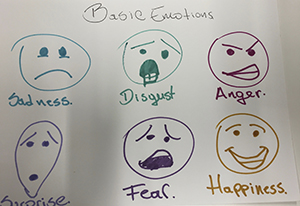EmilioAguas (talk | contribs) No edit summary |
EmilioAguas (talk | contribs) |
||
| Line 59: | Line 59: | ||
For more than 40 years, Paul Ekman has supported the view that emotions are discrete, measurable, and physiologically distinct. Ekman's most influential work revolved around the finding that certain emotions appeared to be universally recognized, even in cultures that were preliterate and could not have learned associations for facial expressions through media. Another classic study found that when participants contorted their facial muscles into distinct facial expressions (e.g. disgust), they reported subjective and physiological experiences that matched the distinct facial expressions. His research findings led him to classify six emotions as basic: anger, disgust, fear, happiness, sadness and surprise | For more than 40 years, Paul Ekman has supported the view that emotions are discrete, measurable, and physiologically distinct. Ekman's most influential work revolved around the finding that certain emotions appeared to be universally recognized, even in cultures that were preliterate and could not have learned associations for facial expressions through media. Another classic study found that when participants contorted their facial muscles into distinct facial expressions (e.g. disgust), they reported subjective and physiological experiences that matched the distinct facial expressions. His research findings led him to classify six emotions as basic: anger, disgust, fear, happiness, sadness and surprise | ||
Take a look on the complete chapter on Basic Emotions by Paul Ekman here[https://www.paulekman.com/wp-content/uploads/2013/07/Basic-Emotions.pdf] | |||
---- | ---- | ||
Revision as of 10:52, 28 November 2015
World Greetings - and social Behavior
Cultural behavior, cultural shock, personal space, environment and surroundings always have an effect in the way we behave and interact with other people.
Our emotions and body gestures are affected by others and the way we try to established a partnership.
Idea
Every time we are in a place surrounded with to many people we feel restrained even more if it's a small place, but also is a good setting to meet people.
When we meet some one new we try to be very formal and not show to much of us, but at the same time our bodies are telling some many things about ourselves to others, like postures and facial expressions.
With the Motion tracking and facial recognition device i will try to attempt to see and understand patterns in our facial expressions; it doesn't matter where you are, where you come from, we feel confortable with people that we already know, and a little awkward the first time we meet or greet some one.
Some cultural behaviors are more well prepared to deal with this kind of situations, because the proxemics they use to greet but with out been rude like bow or just a firm handshake.
An anthropological experiment and analysis could been seen here:
The Social Life of Small Urban Spaces by William H. Whyte [1]
Approximations
First attempt of face tracking into blender
Emotions
6 Basic Emotions of every human being
| *Sadness | *Happiness |
| *Disgust | *Anger |
| *Surprise | *Fear |
For more than 40 years, Paul Ekman has supported the view that emotions are discrete, measurable, and physiologically distinct. Ekman's most influential work revolved around the finding that certain emotions appeared to be universally recognized, even in cultures that were preliterate and could not have learned associations for facial expressions through media. Another classic study found that when participants contorted their facial muscles into distinct facial expressions (e.g. disgust), they reported subjective and physiological experiences that matched the distinct facial expressions. His research findings led him to classify six emotions as basic: anger, disgust, fear, happiness, sadness and surprise
Take a look on the complete chapter on Basic Emotions by Paul Ekman here[2]
